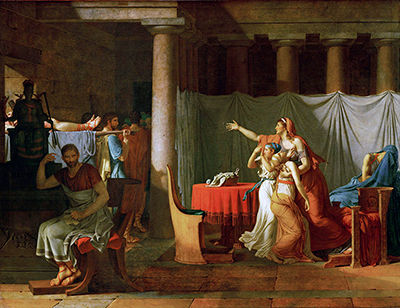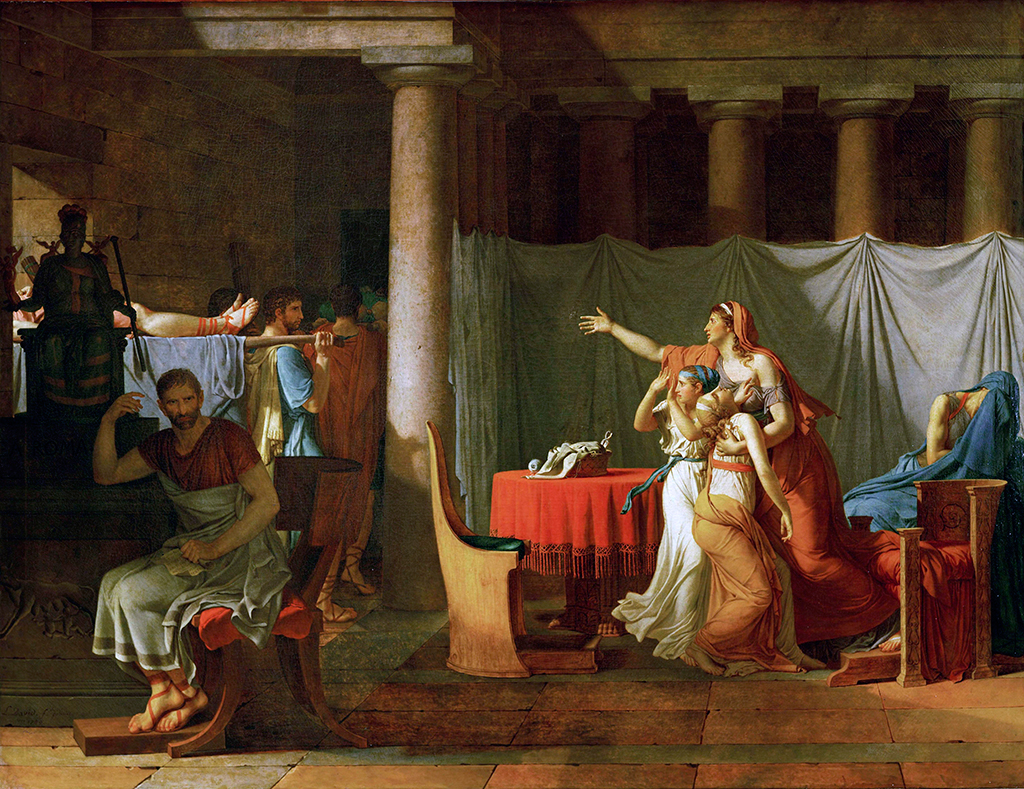Lictors Bearing to Brutus the Bodies of his Sons is an oil-on-canvas painting, executed in the Neoclassical style, by Jacques-Louis David that was released for public consumption in the year 1789 AD.
The painting, completed in the same year that the French Revolution began, was displayed at the Paris Exhibition during a time of great political upheaval and public unrest in the city. David, a member of the infamous Jacobin club and an associate of the notorious Maximilian Robespierre, had been in favour of overthrowing the French monarchy and of establishing the First French Republic and this painting reflects those revolutionary sentiments.
Lucius Junius Brutus, the subject of the painting who had played a pivotal role in the overthrow of the Roman monarchy and the establishment of the Roman Republic, had become an iconic figure among the republican movement of the time and it was feared that the painting would incite the pro-revolutionary crowd to acts of political violence. The painting was exhibited, however, at the insistence of the Parisians and David became a notable figure of the early French Revolution. Brutus, who watched the execution of his own sons for their involvement in the conspiracy to restore the Roman monarchy, served as an example to republicans who believed that the revolution had not gone far enough.
Louis XVI, whose palace at Versailles had been stormed by an angry mob, had begun upon his short career as a constitutional monarch at the time in which the painting was released to the public and had been relocated to the Tuileries Palace in Paris. The painting, measuring 323 cm by 422 cm, could be interpreted as a repudiation of the constitutional monarchy and as a rallying cry for the republican cause. Radicals within the revolutionary movement, gaming influence in the National Assembly, believed that the formation of a constitutional monarchy was a betrayal of revolutionary principles and it could be inferred that such an opinion was being expressed through this painting.
The painting, on current display at the Louvre in Paris, depicts the tragic scene that followed the execution of Titian Junius Brutus and Tiberius Junius Brutus for their betrayal of the Roman Republic. The bereaved father, wearing a red shirt and a white toga that reaches just below his ankles, sits on a chair and faces away from the door through which the first of his dead sons is being carried into the house. The mother, clutching her two young daughters and wearing an anguished expression upon her face, looks towards her dead sons while stretching out her arm and opening her hand. One daughter, holding her hands up to her face, looks towards the door while the other averts her gaze.
A row of four pillars, joined onto another row of four pillars that run along the length of the wall, divides the right and left-hand sides of the painting. Brutus, his back turned to the door that is one of the sources of light in the painting, sits on the left-hand side of the canvas while his wife and daughters stand on the right-hand side. The father sits in the shade, the shadows representing the consul's emotional and psychological state, while the figures of the mother and young sisters are illuminated by the sunlight that enters through the opened door. Another source of light is located behind the grieving wife and daughters while another, illuminating the father's feet, is situated in front of the consul.
Brutus, who placed civic duty above filial piety, reminded the Parisian crowd of the sacrifices and difficult decisions that had to be made in the service of the greater good. It could be said that the painting predicted the Reign of Terror, that was implemented after the abolition of the monarchy to purge French society of counter-revolutionary elements, in which thousands of people were executed on suspicion of subverting the republican cause.
Those looking to understand more about the variety to be found within art history should browse the different art movements and also compare Jacques Louis David's paintings with those of other illustrious names such as Albrecht Durer, Anthony Van Dyck, Vermeer, Hieronymus Bosch and Jan van Eyck. The continent has had significant contributions from right across its wide spread of land, though most significantly from Italy and the Netherlands.





